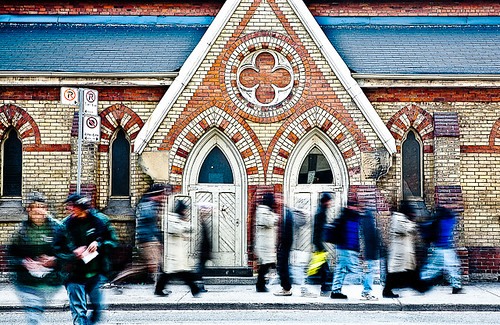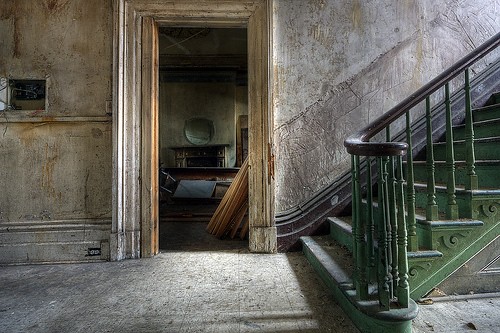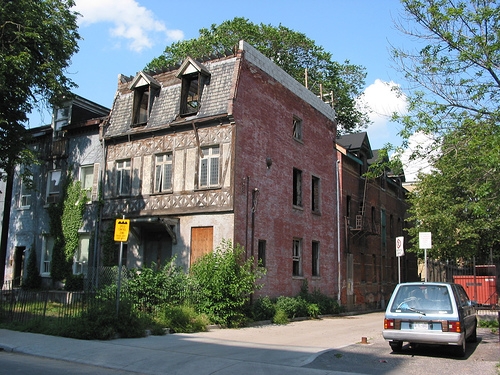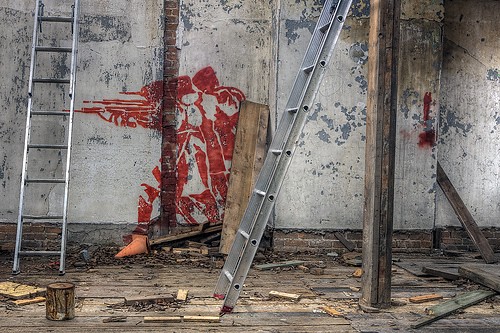
295 George Street, 2008, by Olena Sullivan
EDITOR’S NOTE: Heritage Toronto’s Gary Miedema will be making a series of posts on structures around the city included in their upcoming “Building Storeys†exhibit at the Gladstone Hotel that runs February 17-22.
– – – – – – – – – – – – – – –
A few years ago, I was on my bike heading up to Allan Gardens and thought I’d bypass Jarvis by riding the residential streets to the east. When I hit George Street going north off of Dundas, my legs stopped peddling and I coasted, trying to make sense of the view — a line of neglected buildings including two that have been abandoned, windows boarded or gaping black over garbage strewn lawns.
My guess is that most readers of this website will already know that Jarvis Street, one block to the west, used to be one of Toronto’s finer neighbourhoods — a fact made clear by the architectural pedigree of its remaining homes. “Of all the avenues extending south from Bloor Street to the Bay,†judged the writer of Toronto:Past and Present in 1882, “the noblest are Church, Jarvis and Sherbourne Streetsâ€, with the latter two boasting “the mansions of the upper ten.†George Street, squeezed between them, caught “the refined tone of the neighbourhood†as it passed north of today’s Dundas Street, and stopped at one of the city’s gems, Allan Gardens.
It may not be surprising, then, that three of the 14 buildings photographed for the “Building Storeys†exhibit can be found in this neighbourhood. Step inside All Saints Community Centre on the corner of Dundas and Sherbourne, and you can see that this former parish church once had wealthy patrons. Completed in 1874, the church is a beautiful example of the exuberance of the High Gothic style of the Victorian period.

All Saints Community Centre, 2008 by Toni Wallachy
Back on George Street, only two blocks away, the two vacant and derelict homes, numbers 295 and 305, are among the city’s oldest — dating to circa 1856 and 1858. The home at 295, in fact, was early enough to appear on the 1858 Boulton’s Atlas, and has been catalogued in ERA Architects’ presentation at Harbourfront Centre about both the atlas itself and of all the buildings in it that are still standing today.
The homes at 295 and 305 were constructed shortly after the death in 1853 of William Allan, the man who owned Park Lot V, which stretched all the way from just east of Jarvis to Sherbourne, and from Queen to Bloor. George Allan, William’s son, moved back into the estate house called Moss Park (which was later demolished, and which is now the site of the Moss Park Arena and community centre). George subdivided the land to the immediate north of Moss Park, then played out his love for horticulture and made his subdivision that much more saleable – in 1861, he donated what is today “Allan Gardens†to the Toronto Horticultural Society.
While the “Botanical Garden†(as Allan Gardens was first called) was being planned, the home at 305 George Street was built for Thomas Meredith, a grain merchant who had a strong association with the Gooderham and Worts Distillery. Now a dull grey, painted brick home with slider and boarded windows, it once was a gracious example of the Italianate style of residential architecture, complete with a red brick faà§ade with buff (or yellow) brick detailing. The Meredith family owned the house until 1911. Though it has no doubt been a rooming house and is now vacant, the elaborate plaster mouldings and six of the seven fireplace mantels (that’s right, seven fireplaces) are still largely intact. A recent photo of the back of the home still captures some of its former beauty.

Rear of Thomas Meredith House, 305 George Street, in 2006 by Scott Weir

Interior of Thomas Meredith House, 2008 by Timothy Neesam

Interior of Thomas Meredith House, 2008 by Timothy Neesam
At 295 George, the story is very different. With its neighbour at 297, the home seems to have been constructed in about 1856 as a rental property. Its original appearance is hard to figure out, but my guess is that it was once the mirror image of its neighbour, with a window where the grand front door is now and a regular door where the window on the right now appears (a close look shows no stone lintel over that window). Beneath its paint are hints of the same red and yellow brick of Thomas Meredith’s house.
For its first few years, 295 George changed owners and tenants frequently. Then, in the mid-1880s, it was acquired by Toronto businessman William Gooderham and donated to W.C. Fegan, a British man who had begun bringing destitute British boys to Canada to give them a better future. In 1887, the home became the Fegan Boys Distributing Home, and it is more than likely that the long addition of rooms to the rear of the original house (and perhaps the mansard roof on the third floor) were added thereafter to house the boys until they were lined up with a home and a job. I would assume that the Tudor style woodwork on the faà§ade was a later addition as well.

295 George Street in 2006. Note the total lack of a roof (since partially repaired). by Scott Weir
By 1939, when the Fegan organization left 295 George Street for new digs on Broadview Avenue, something like 3,000 British boys had found new lives in Canada. The house at 295 George then became the new location of the “Society of Crippled Civilians.â€
Today, 295 George Street must be on its way to collapse. It was apparently torn apart for renovation a few years back, the roof partly rebuilt, and then abandoned. With windows and the roof open to the weather, it cannot survive.

Interior of 295 George Street, 2008. Open to the elements, with ladders still standing in place by Timothy Neesam

Interior of 295 George Street, 2008 by Toni Wallachy
The context of these homes explains their plight. According to an article in the National Post last year, the streets surrounding and including George Street have the highest concentration of shelters and substance-abuse facilities in the city. Just a few doors up from 295 and 305 George is Seaton House, with beds for 600 homeless men.
That makes for a tough neighbourhood, and makes the condition of these historic homes heartbreakingly appropriate.
– – – – – – – – – – – – – –
These homes are included in Building Storeys: A Photo Exhibit of Toronto’s Aging Spaces, held at the Gladstone Hotel from February 17-22. For more information, www.heritagetoronto.org.




9 comments
I have lived in the general neighbourhood for about 4 years. While the area is certianly sketchy, George St. north of Shuter seems like an alternate universe! This section of George St. is the closest thing in Toronto to Vancouver’s Hastings. It should be noted that George Street continues south of Moss Park, and it’s rather normal (the Starbucks at King & George is in particular quite beautiful).
Thank you for the well researched article.
Who owns these buildings now? Can any realtors hop on their jazzed-up MLS site and give us some details on transaction history/prices?
I stayed a night in a hostel on George once, though I didn’t notice either of these two buildings. I can see why they don’t have much appeal, though, the street isn’t in the best of shape. I’m pretty used to being in urban areas and places that can be described as “sketchy”, and I didn’t feel terribly comfortable on George. Which is unfortunate, because it was a beautiful street, otherwise…
Both buildings are privately owned, but I didn’t dig up the names.
Great suggestion on the transaction history.
Wonderful images and I look forward to reading more about this aspect of Toronto’s otherwise neglected urban decay…and how it might be transformed to be made vibrant once again: these are beautiful and historically signifificant structures!!
Thanks,
J
urbanfluteproject
An understanding of the history of this neighbourhood and its buildings requires an understanding of the social and cultural history of the neighbourhood–something that is all but missing in this article.
Historically, poverty has been as much a part of this neighbourhood as the wealth that is so well documented in the history books. Most interesting is that historically, the wealthy provided for the poor (and architecturally beautiful poorhouses resulted)–a tradition that seems to be eroding.
Gaetan Heroux’s presentation, “Relief and Resistance: A Poor People’s History of East Downtown Toronto” on March 13th at U of T will add some important context to this article. Details at: http://www.geog.utoronto.ca/programs/planning/planning-news-events/john-bousfield-distinguished-visitor-in-planning
As for the comment about neighbourhood transformation, this neglect and urban decay of the built environment is reflective the neglect and resultant decay of the people who call this area home. I find it difficult to pity the crumbling of once-beautiful buildings without thinking about the once-beautiful people who are similarly crumbling around and inside of those buildings.
Investing in the people of the neighbourhood and the social infrastructure they rely upon would have positive effects on the built environment. That would be a progressive approach to neighbourhood transformation.
A regressive approach would be to underfund welfare programs and social services, criminalize the behaviour of people affected by this underfunding, and either throw people in jail or move them into housing that is far from the downtown core (and social services and supports), so that the city can justify closing Seaton House and neighbouring shelters, leaving the area free to gentrify. This seems to be the path Toronto is pursuing, which is a more subtle version of Giuliani’s brutal approach in NYC.
Thanks for the careful comments, Melissa, and for the reference to Gaetan Heroux’s presentation. The article was aimed more at the buildings than the neighbourhood, and I appreciate the critique.
For what it is worth, I intended the last line of the article to say in a few words what you state much more clearly – “that the neglect and urban decay of the built environment is reflective of the neglect and resultant decay of the people who call this area home.” I agree that we cannot privilege the survival of a building over the well being of people, and I like your suggestion of a way to care for both.
Incidentally, the article notes it in action. William Gooderham, a wealthy businessman, transferred 295 George Street to W.C. Fegan so that it could serve as transitional housing for poor British boys in need. That did not mean the house went into decline or lost its charm. In stead, by my guess based on the architectural details of the house, it reached its height of “grandnessâ€Â. Just compare it with the more humble building adjoined to it – likely once its mirror image. An interesting example of caring for people in need and the neighbourhood at the same time.
That said, my guess is that poverty on George Street in the 1880s and poverty on George Street today are two very different things. My guess is that the concentration of people in Seaton House is as hard on them as it is on the neighbourhood. Beyond the issue of funding, there’s the issue how much poverty and illness any one neighbourhood can absorb.
my father own 2 of the 3 buildings in the pics
I felt like I’d been kicked in the gut when I woke up to see Walnut Hall down the street being bulldozed. I’ve lived directly across from 295 George for 15 years and fear it won’t last long. Sorry Ms. Goldstein, but big box warehouses for human beings do no one any good (except for pimps and dealers and city executives). Dispersal is the answer. Why is it ‘poverty activists’ never seem to live in the poverty?
I thank you for your well written article and the sensitivety in your approach. My father was raised on George Street during the 1920’s. His place of residence was known as a wards home for boys. I believe the building once sat at 305 George St., prior to demolishing and replacement with the Seaton House building. I have spent hours trying to find archieves, pictures and history to both the street, and buildings – but to no avail. It would be nice to hear, see and find more of this streets history.